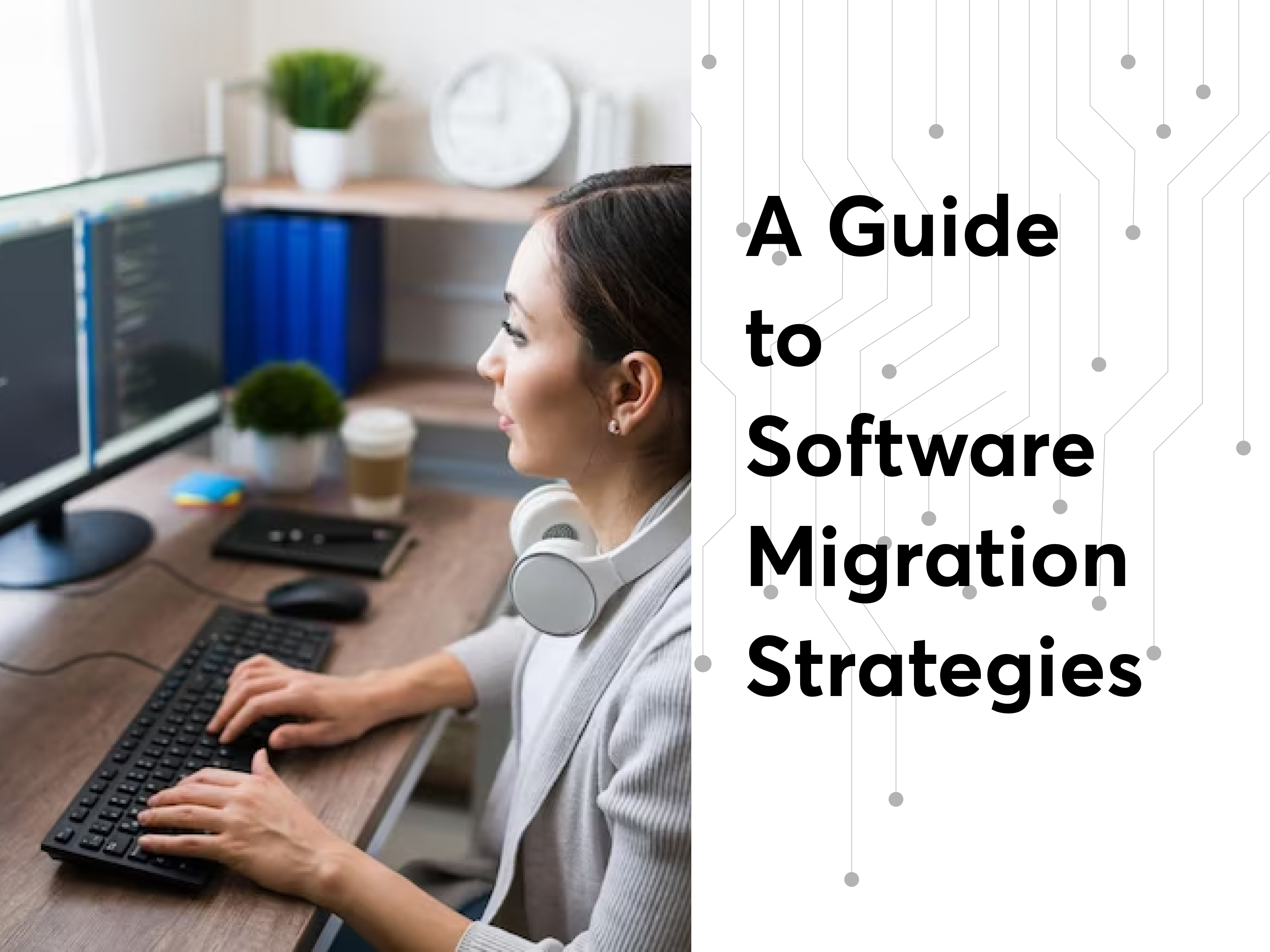A Guide to Software Migration Strategies
 Jones Adams
Jones Adams
Introduction
Technology, software migration has become a common necessity for businesses and organizations of all sizes. Whether it's upgrading to a newer version of an operating system, transitioning to a cloud-based solution, or moving from a legacy system to a modern one, software migration is a critical step in staying competitive and ensuring long-term sustainability. However, the process can be complex and fraught with challenges if not approached strategically. In this comprehensive guide, we will explore the world of software migration, its significance, and various strategies to make it a seamless and successful endeavor.
Understanding Software Migration
Software migration refers to the process of transferring an existing software system or application from one environment to another. This could involve moving from on-premises servers to the cloud, updating to a newer version of an operating system, or switching from one software platform to another. The primary motivations behind software migration include:
1. Enhancing Performance: As technology advances, older software may become inefficient or unable to meet the growing demands of a business. Migrating to a more modern system can improve performance and functionality.
2. Security: Legacy systems may lack essential security features and updates, leaving them vulnerable to cyber threats. Migrating to a more secure environment can mitigate these risks.
3. Cost Reduction: Older systems can be expensive to maintain, and software providers may discontinue support for outdated versions. Migrating to newer solutions can result in cost savings.
4. Scalability: Growing businesses often require software that can scale with their needs. Migrating to a cloud-based solution, for example, can provide scalability benefits.
5. Compliance: Changes in industry regulations or data protection laws may necessitate software migration to ensure compliance.
The Importance of Planning
Before diving into the various migration strategies, it's essential to emphasize the critical role of planning in the software migration process. Proper planning can make the difference between a smooth transition and a costly, disruptive one. Here are some key steps in the planning phase:
1. Define Objectives and Goals
Begin by clearly defining your migration objectives and goals. What do you hope to achieve with the migration? Are you aiming to reduce costs, improve performance, enhance security, or achieve compliance? Understanding your goals will guide the entire migration process.
2. Assess Current State
Thoroughly assess your current software environment. Document all components, dependencies, and integrations. This assessment should include hardware, software, data, and any customizations.
3. Risk Assessment
Identify potential risks and challenges that may arise during migration. This could include data loss, downtime, or compatibility issues. Developing a risk mitigation plan is crucial.
4. Budget and Resource Allocation
Estimate the costs associated with migration, including hardware, software, labor, and any additional expenses. Allocate the necessary resources and budget accordingly.
5. Create a Timeline
Develop a realistic migration timeline that considers all the tasks involved, from preparation to testing and deployment. Ensure that the timeline aligns with your business goals and operational needs.
6. Choose the Right Migration Strategy
Selecting the appropriate migration strategy is crucial to the success of the project. Let's explore some common migration strategies and their suitability for different scenarios.
Software Migration Strategies
1. Rehost (Lift and Shift)
Description: Rehosting, also known as "lift and shift," involves moving your existing software and data to a new environment without making significant changes to the application's architecture. This is typically used when you want to migrate to a different infrastructure while keeping the software largely unchanged.
Suitability: Rehosting is suitable when you need a quick migration with minimal code modifications. It's a good choice for moving on-premises applications to the cloud or changing hosting providers.
Advantages:
- Faster migration.
- Minimal disruption to the application.
- Reduced risk of compatibility issues.
Challenges:
- May not fully leverage the benefits of the new environment.
- Potential cost savings are limited.
2. Replatform (lift, tinker, and shift)
Description: Replatforming involves making minor adjustments to the application during migration to optimize it for the target environment. This strategy can include updating the application or database to a newer version or adjusting configurations.
Suitability: Replatforming is suitable when you want to take advantage of some benefits of the new environment while minimizing changes to the application's core functionality.
Advantages:
- Improved performance and scalability.
- Minor code enhancements.
- Reduced risk compared to a full rewrite.
Challenges:
- Requires more planning and testing than rehosting.
- Some compatibility issues may still arise.
3. Refactor (rearchitecture)
Description: Refactoring, or rearchitecting, involves making significant changes to the application's architecture and codebase to optimize it for the new environment. This can include modernizing the application, breaking monolithic structures into microservices, or rewriting portions of the code.
Suitability: Refactoring is suitable when you want to fully leverage the benefits of the new environment and are willing to invest in significant code changes.
Advantages:
- Optimized for the target environment.
- Improved scalability, flexibility, and performance.
- Long-term sustainability.
Challenges:
- Requires a substantial investment of time and resources.
- Higher risk of disruptions during migration.
4. Rearchitect and Rebuild (redesign)
Description: Rearchitecting and rebuilding involves designing and developing a completely new application for the target environment. This is often chosen when the existing application is outdated, no longer meeting business needs, or has accumulated technical debt.
Suitability: Rearchitecting and rebuilding are suitable when you want to start fresh with a modern, cloud-native application that takes full advantage of the new environment.
Advantages:
- Ultimate flexibility and scalability.
- Modern, efficient codebase.
- Alignment with the latest industry standards and best practices.
Challenges:
- Highest cost and resource investment.
- Longer development timeline.
- Highest level of risk.
5. Retire or Retain
Description: In some cases, the best strategy might be to retire certain applications that are no longer needed or relevant. On the other hand, you may choose to retain certain legacy systems for various reasons, such as compliance or specific functionality.
Suitability: The decision to retire or retain should be based on a thorough evaluation of each application's value, cost of maintenance, and alignment with business objectives.
Advantages:
- Cost savings from retiring unnecessary applications.
- Preservation of critical functionality when retaining legacy systems.
Challenges:
- Proper data migration and archiving are essential for retiring applications.
- Retaining legacy systems may require ongoing maintenance and security updates.
The Migration Process
Once you've selected the most appropriate migration strategy, you can proceed with the migration process. While the specific steps may vary depending on your strategy and the complexity of your environment, here is a general outline of the migration process:
1. Pre-migration Preparation
- Backup your data and applications to ensure data integrity.
- Provision the target environment, whether it's a new data center, cloud infrastructure, or a different platform.
- Train your team on the new environment and migration procedures.
2. Data Migration
- Transfer data from the source to the target environment. This may involve data cleansing, transformation, and validation
- Ensure data consistency and accuracy during the migration.
3. Application Migration
- If necessary, modify the application code to align with the chosen migration strategy.
- Test the application thoroughly in the new environment to identify and resolve any issues.
4. Testing
- Conduct comprehensive testing, including functional, performance, and security testing.
- Validate that the migrated application meets all business requirements and performance expectations.
5. Deployment
- Plan the cutover carefully to minimize downtime and disruptions.
- Monitor the migration process closely and have a rollback plan in case of unexpected issues.
6. Post-migration Optimization
- Continuously monitor the performance of the migrated application and address any post-migration issues promptly.
- Optimize configurations and settings to ensure optimal performance.
7. Documentation and Training
- Update documentation to reflect the changes introduced by migration.
- Provide training for your team to familiarize them with the new environment and any modifications to the application.
Best Practices for Successful Software Migration
To ensure a successful software migration, consider the following best practices:
1. Communication and Stakeholder Involvement
Maintain open communication with all stakeholders throughout the migration process. Involve key team members and users early to gather feedback and address concerns.
2. Testing and Validation
Thoroughly test the migrated application in the new environment. Use automated testing tools whenever possible to identify issues quickly.
3. Risk Management
Develop a robust risk mitigation plan and be prepared to address unexpected challenges. Regularly assess and update your risk assessment throughout the migration.
4. Data Backup and Recovery
Ensure that you have reliable data backup and recovery mechanisms in place to prevent data loss during migration.
5. Documentation
Document every aspect of the migration process, including configurations, settings, and changes made to the application. This documentation is crucial for troubleshooting and future reference.
6. Continuous Monitoring
After migration, implement continuous monitoring and performance optimization practices to identify and resolve issues promptly.
Conclusion
Software migration is a complex but essential process for organizations aiming to stay competitive and secure in today's rapidly changing technological landscape. By understanding the various migration strategies, planning meticulously, and following best practices, you can successfully navigate the challenges of software migration and reap the benefits of improved performance, security, and scalability. Remember that each migration is unique, and the choice of strategy should align with your specific business objectives and constraints. Ultimately, a well-executed migration can position your organization for long-term success in an ever-evolving digital world.
Subscribe to my newsletter
Read articles from Jones Adams directly inside your inbox. Subscribe to the newsletter, and don't miss out.
Written by

Jones Adams
Jones Adams
Serving Business Leader to Digital Solutions for more than 12 years. Passion for technology and to transform modern businesses with advent of innovation.